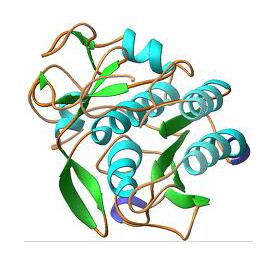Proteinase K

Product description:Proteinase K (also protease K or endopeptidase K) EC 3.4.21.64 is a broad-spectrum serine protease. The enzyme was discovered in 1974 in extracts of the fungus Engyodontium album (formerly Tritirachium album).Proteinase K is able to digest native keratin (hair), hence, the name "Proteinase K". The predominant site of cleavage is the peptide bond adjacent to the carboxyl group of aliphatic and aromatic amino acids with blocked alpha amino groups. It is commonly used for its broad specificity. This enzyme belongs to Peptidase family S8.
Molecular weight of Proteinase K is 28,900 daltons (~28.9 KDa). Although calcium ions do not affect the enzyme activity, they do contribute to its stability when present at a concentration of 1 - 5 μmoles. An interesting characteristic of proteinase K is that it retains its activity in the presence of sodium dodecyl sulphate (SDS) or urea. (0.5 - 1% SDS and 1 - 4 M urea). Raising the temperature of the reaction from 37°C to 50°C - 60°C can increase the activity several folds. A special feature of proteinase K is its ability to digest native proteins, thereby inactivating enzymes such as DNase and RNase without recourse to a denaturation process. In addition to cleavage of peptide bonds, it also catalyzes peptide amide hydrolysis. Proteinase K is inactivated by diisopropyl fluorophosphate (DFP) or phenyl methane sulphonyl fluoride (PMSF). Chelating agents such as citrate and EDTA have no effect on the enzyme activity.
Proteinase K is very useful in the isolation of highly native, undamaged DNAs or RNAs, since most microbial or mammalian DNases and RNases are rapidly inactivated by the enzyme, particularly in the presence of 0.5 - 1% SDS. Proteinase K is commonly used in molecular biology to digest protein and remove contamination from preparations of nucleic acid. Addition of proteinase K to nucleic acid preparations rapidly inactivates nucleases that might otherwise degrade the DNA or RNA during purification. It is highly-suited to this application since the enzyme is active in the presence of chemicals that denature proteins, such as SDS and urea, chelating agents such as EDTA, sulfhydryl reagents, as well as trypsin or chymotrypsin inhibitors. Proteinase K is also stable over a wide pH range (4-12), with a pH optimum of pH 7.5-12.
The enzyme's activity towards native proteins is stimulated by denaturants such as SDS. In contrast, when measured using peptide substrates, denaturants inhibit the enzyme. The reason for this result is that the denaturing agents unfold the protein substrates and make them more accessible to the protease.
Disclaimer: the information on this website is from the internet for reference only. Please refer to the actual instructions attached to the product and the final interpretation is owned by the company.
 for: Product Quotation ( Product suppliers),COA (Certificate of Analysis), New Sales
for: Product Quotation ( Product suppliers),COA (Certificate of Analysis), New Sales
Promotion,New Products,And any other assistance.
 After send online enquiry, we will reply you as soon as possible, if not get any response on time please contact us by Tel or Email.
After send online enquiry, we will reply you as soon as possible, if not get any response on time please contact us by Tel or Email.
1. Email: info@abpri.com
2. Tel: +86 592 5365887
3. WhatsApp: +86 189 6516 2351
4. Send enquiry online:


